Seat Alhambra 2011 Owner's Manual
Manufacturer: SEAT, Model Year: 2011, Model line: Alhambra, Model: Seat Alhambra 2011Pages: 385, PDF Size: 7.92 MB
Page 241 of 385
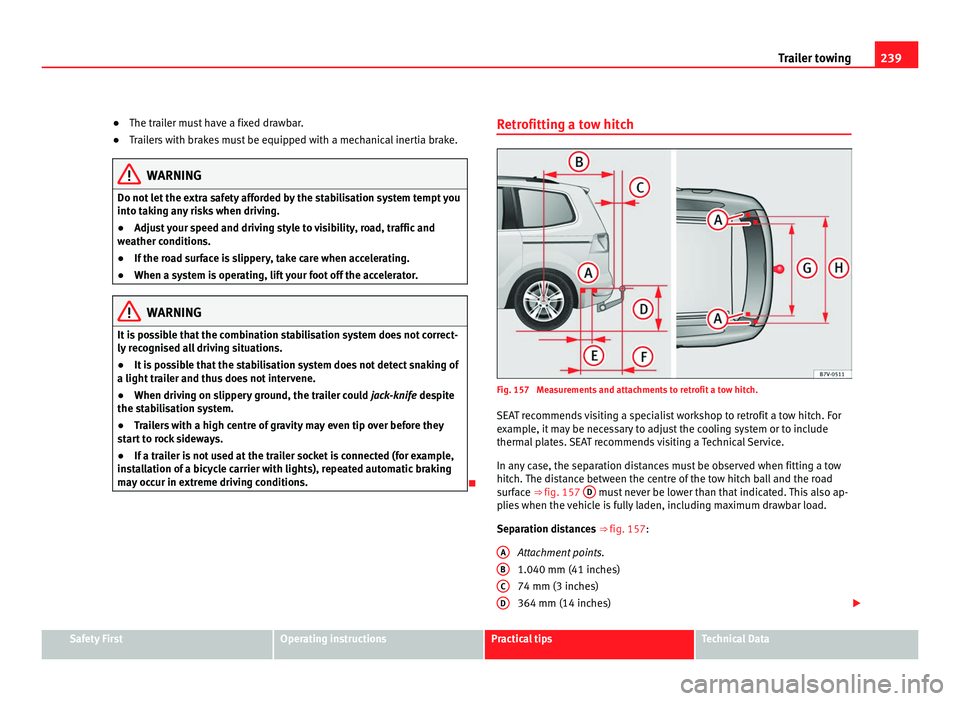
239
Trailer towing
● The trailer must have a fixed drawbar.
● Tr
ailers with brakes must be equipped with a mechanical inertia brake. WARNING
Do not let the extra safety afforded by the stabilisation system tempt you
into t ak
ing any risks when driving.
● Adjust your speed and driving style to visibility, road, traffic and
weather c
onditions.
● If the road surface is slippery, take care when accelerating.
● When a system is operating, lift your foot off the accelerator. WARNING
It is possible that the combination stabilisation system does not correct-
ly r ec
ognised all driving situations.
● It is possible that the stabilisation system does not detect snaking of
a light trai
ler and thus does not intervene.
● When driving on slippery ground, the trailer could jack-knife
despite
the stabilisation system.
● Trailers with a high centre of gravity may even tip over before they
star
t to rock sideways.
● If a trailer is not used at the trailer socket is connected (for example,
inst
allation of a bicycle carrier with lights), repeated automatic braking
may occur in extreme driving conditions. Retrofitting a tow hitch
Fig. 157 Measurements and attachments to retrofit a tow hitch.
SEA T r
ecommends visiting a specialist workshop to retrofit a tow hitch. For
example, it may be necessary to adjust the cooling system or to include
thermal plates. SEAT recommends visiting a Technical Service.
In any case, the separation distances must be observed when fitting a tow
hitch. The distance between the centre of the tow hitch ball and the road
surface ⇒ fig. 157 D must never be lower than that indicated. This also ap-
plie s
when the vehicle is fully laden, including maximum drawbar load.
Separation distances ⇒ fig. 157:
Attachment points.
1.040 mm (41 inches)
74 mm (3 inches)
364 mm (14 inches)
A B
C
D
Safety First Operating instructions Practical tips Technical Data
Page 242 of 385
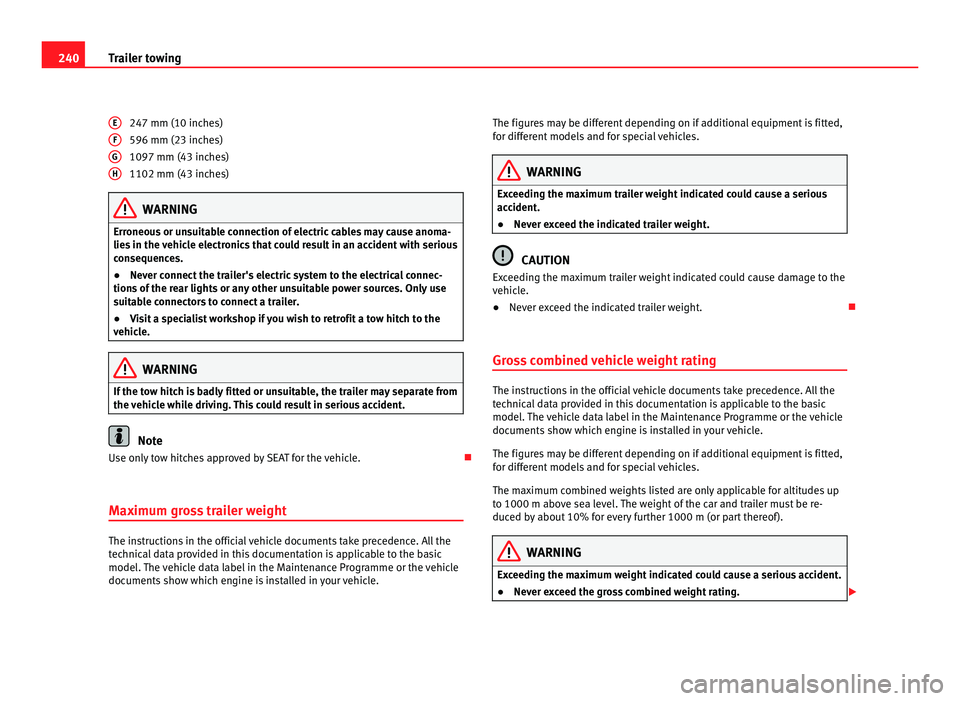
240
Trailer towing
247 mm (10 inches)
596 mm (23 inche s)
1097 mm (43 inc
hes)
1102 mm (43 inches) WARNING
Erroneous or unsuitable connection of electric cables may cause anoma-
lies in the
vehicle electronics that could result in an accident with serious
consequences.
● Never connect the trailer's electric system to the electrical connec-
tions of
the rear lights or any other unsuitable power sources. Only use
suitable connectors to connect a trailer.
● Visit a specialist workshop if you wish to retrofit a tow hitch to the
vehicl
e. WARNING
If the tow hitch is badly fitted or unsuitable, the trailer may separate from
the v ehic
le while driving. This could result in serious accident. Note
Use only tow hitches approved by SEAT for the vehicle.
Maximum gross trailer weight The instructions in the official vehicle documents take precedence. All the
tec
hnic
al data provided in this documentation is applicable to the basic
model. The vehicle data label in the Maintenance Programme or the vehicle
documents show which engine is installed in your vehicle. E F
G
H The figures may be different depending on if additional equipment is fitted,
for diff
er
ent models and for special vehicles. WARNING
Exceeding the maximum trailer weight indicated could cause a serious
acc ident
.
● Never exceed the indicated trailer weight. CAUTION
Exceeding the maximum trailer weight indicated could cause damage to the
vehic l
e.
● Never exceed the indicated trailer weight.
Gross combined vehicle weight rating The instructions in the official vehicle documents take precedence. All the
tec
hnic
al data provided in this documentation is applicable to the basic
model. The vehicle data label in the Maintenance Programme or the vehicle
documents show which engine is installed in your vehicle.
The figures may be different depending on if additional equipment is fitted,
for different models and for special vehicles.
The maximum combined weights listed are only applicable for altitudes up
to 1000 m above sea level. The weight of the car and trailer must be re-
duced by about 10% for every further 1000 m (or part thereof). WARNING
Exceeding the maximum weight indicated could cause a serious accident.
● Never exceed the gross combined weight rating.
Page 243 of 385
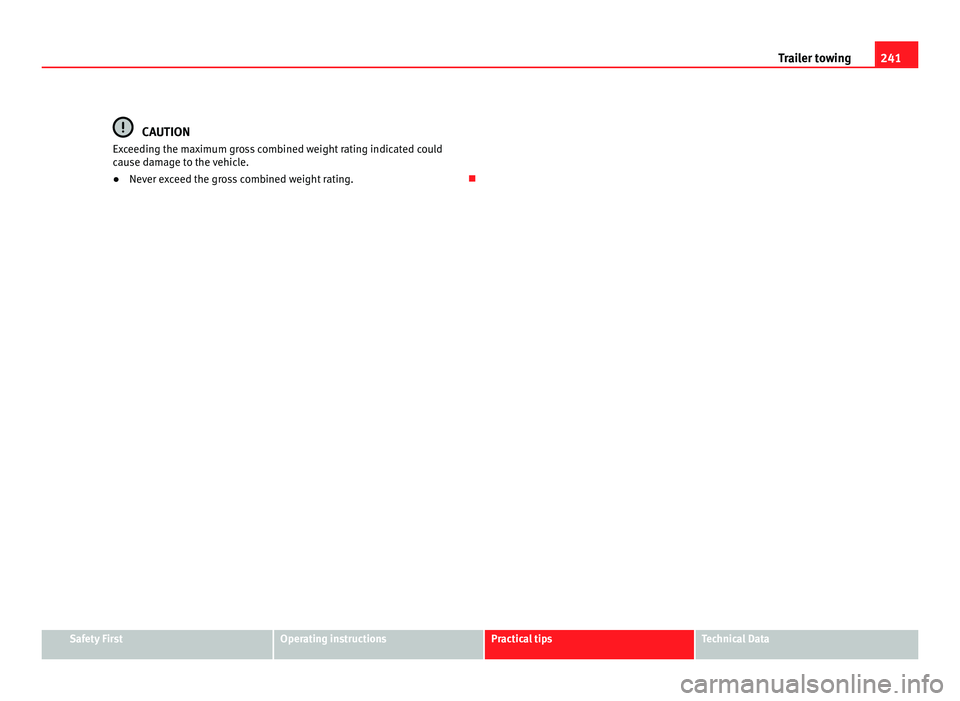
241
Trailer towing CAUTION
Exceeding the maximum gross combined weight rating indicated could
cau se d
amage to the vehicle.
● Never exceed the gross combined weight rating. Safety First Operating instructions Practical tips Technical Data
Page 244 of 385
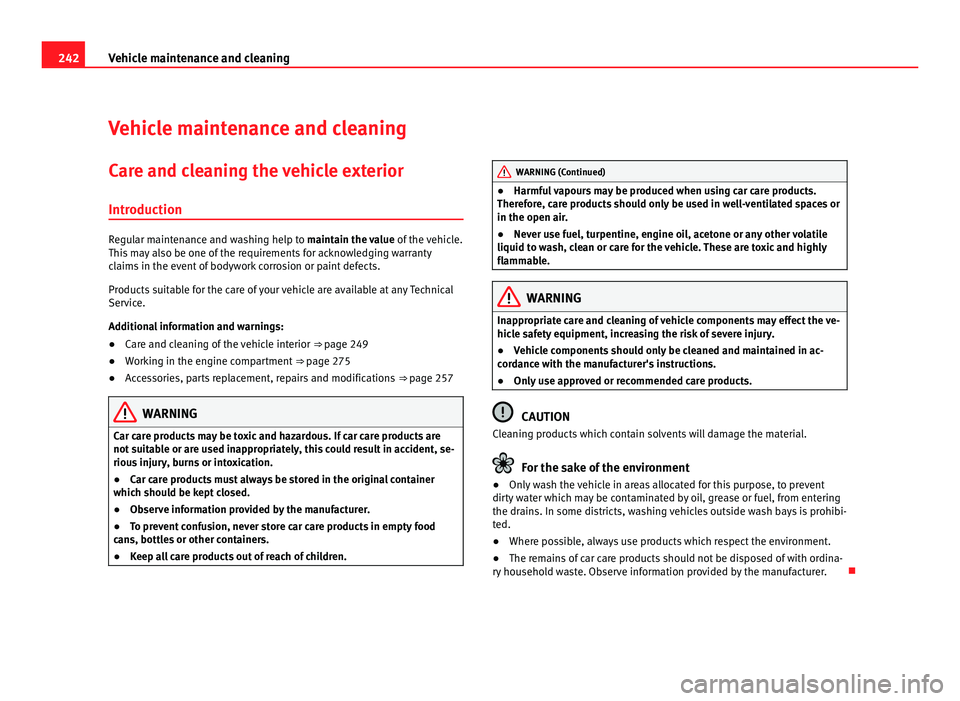
242
Vehicle maintenance and cleaning
Vehicle maintenance and cleaning
Care and cleaning the vehicle exterior
Introduction Regular maintenance and washing help to maint
ain the value of the vehicle.
This may also be one of the requirements for acknowledging warranty
claims in the event of bodywork corrosion or paint defects.
Products suitable for the care of your vehicle are available at any Technical
Service.
Additional information and warnings:
● Care and cleaning of the vehicle interior ⇒ page 249
● W
orking in the engine compartment ⇒ page 275
● A
ccessories, parts replacement, repairs and modifications ⇒ page 257WARNING
Car care products may be toxic and hazardous. If car care products are
not s uit
able or are used inappropriately, this could result in accident, se-
rious injury, burns or intoxication.
● Car care products must always be stored in the original container
which shoul
d be kept closed.
● Observe information provided by the manufacturer.
● To prevent confusion, never store car care products in empty food
cans, bottl
es or other containers.
● Keep all care products out of reach of children. WARNING (Continued)
● Harmf ul vapours may be produced when using car care products.
Ther ef
ore, care products should only be used in well-ventilated spaces or
in the open air.
● Never use fuel, turpentine, engine oil, acetone or any other volatile
liquid to w
ash, clean or care for the vehicle. These are toxic and highly
flammable. WARNING
Inappropriate care and cleaning of vehicle components may effect the ve-
hicl e s
afety equipment, increasing the risk of severe injury.
● Vehicle components should only be cleaned and maintained in ac-
cord
ance with the manufacturer's instructions.
● Only use approved or recommended care products. CAUTION
Cleaning products which contain solvents will damage the material. For the sake of the environment
● Only wash the vehicle in areas allocated for this purpose, to prevent
dir ty
water which may be contaminated by oil, grease or fuel, from entering
the drains. In some districts, washing vehicles outside wash bays is prohibi-
ted.
● Where possible, always use products which respect the environment.
● The remains of car care products should not be disposed of with ordina-
ry hou
sehold waste. Observe information provided by the manufacturer.
Page 245 of 385
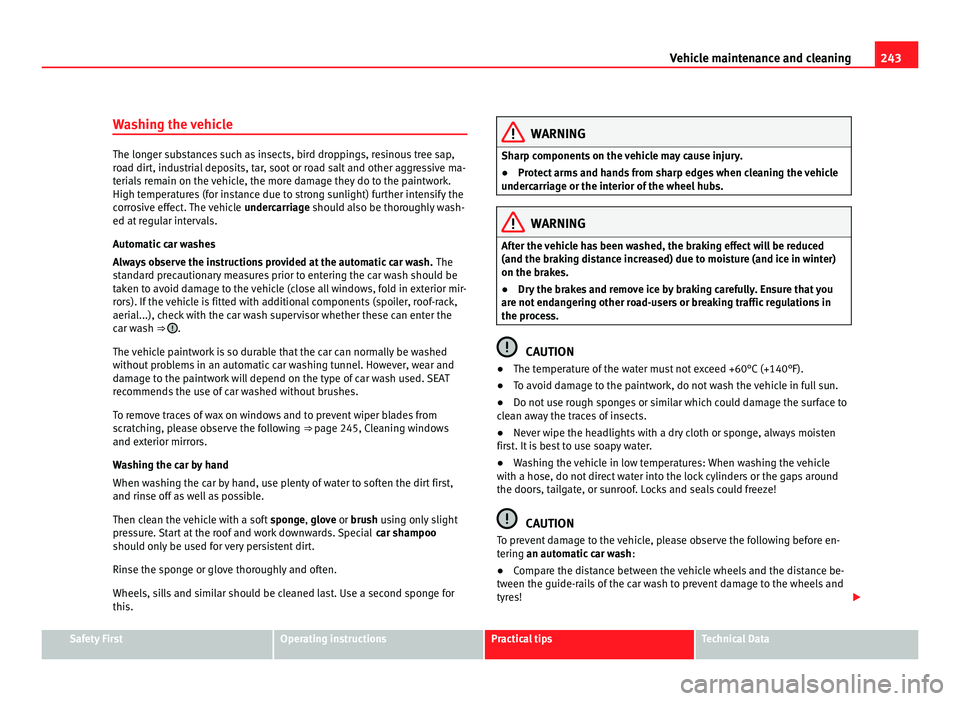
243
Vehicle maintenance and cleaning
Washing the vehicle The longer substances such as insects, bird droppings, resinous tree sap,
ro
a
d dirt, industrial deposits, tar, soot or road salt and other aggressive ma-
terials remain on the vehicle, the more damage they do to the paintwork.
High temperatures (for instance due to strong sunlight) further intensify the
corrosive effect. The vehicle undercarriage should also be thoroughly wash-
ed at regular intervals.
Automatic car washes
Always observe the instructions provided at the automatic car wash. The
standard precautionary measures prior to entering the car wash should be
taken to avoid damage to the vehicle (close all windows, fold in exterior mir-
rors). If the vehicle is fitted with additional components (spoiler, roof-rack,
aerial...), check with the car wash supervisor whether these can enter the
car wash ⇒ .
The v ehic
le paintwork is so durable that the car can normally be washed
without problems in an automatic car washing tunnel. However, wear and
damage to the paintwork will depend on the type of car wash used. SEAT
recommends the use of car washed without brushes.
To remove traces of wax on windows and to prevent wiper blades from
scratching, please observe the following ⇒ page 245, Cleaning windows
and exterior mirrors.
Washing the car by hand
When washing the car by hand, use plenty of water to soften the dirt first,
and rinse off as well as possible.
Then clean the vehicle with a soft sponge, glove or brush using only slight
pressure. Start at the roof and work downwards. Special car shampoo
should only be used for very persistent dirt.
Rinse the sponge or glove thoroughly and often.
Wheels, sills and similar should be cleaned last. Use a second sponge for
this. WARNING
Sharp components on the vehicle may cause injury.
● Protect arms and hands from sharp edges when cleaning the vehicle
under c
arriage or the interior of the wheel hubs. WARNING
After the vehicle has been washed, the braking effect will be reduced
(and the brakin
g distance increased) due to moisture (and ice in winter)
on the brakes.
● Dry the brakes and remove ice by braking carefully. Ensure that you
are not end
angering other road-users or breaking traffic regulations in
the process. CAUTION
● The temperature of the water must not exceed +60°C (+140°F).
● To av
oid damage to the paintwork, do not wash the vehicle in full sun.
● Do not use rough sponges or similar which could damage the surface to
cle
an away the traces of insects.
● Never wipe the headlights with a dry cloth or sponge, always moisten
first
. It is best to use soapy water.
● Washing the vehicle in low temperatures: When washing the vehicle
with a hose, do not
direct water into the lock cylinders or the gaps around
the doors, tailgate, or sunroof. Locks and seals could freeze! CAUTION
To prevent damage to the vehicle, please observe the following before en-
terin g
an automatic car wash :
● Compare the distance between the vehicle wheels and the distance be-
tween the guide-rai
ls of the car wash to prevent damage to the wheels and
tyres! Safety First Operating instructions Practical tips Technical Data
Page 246 of 385
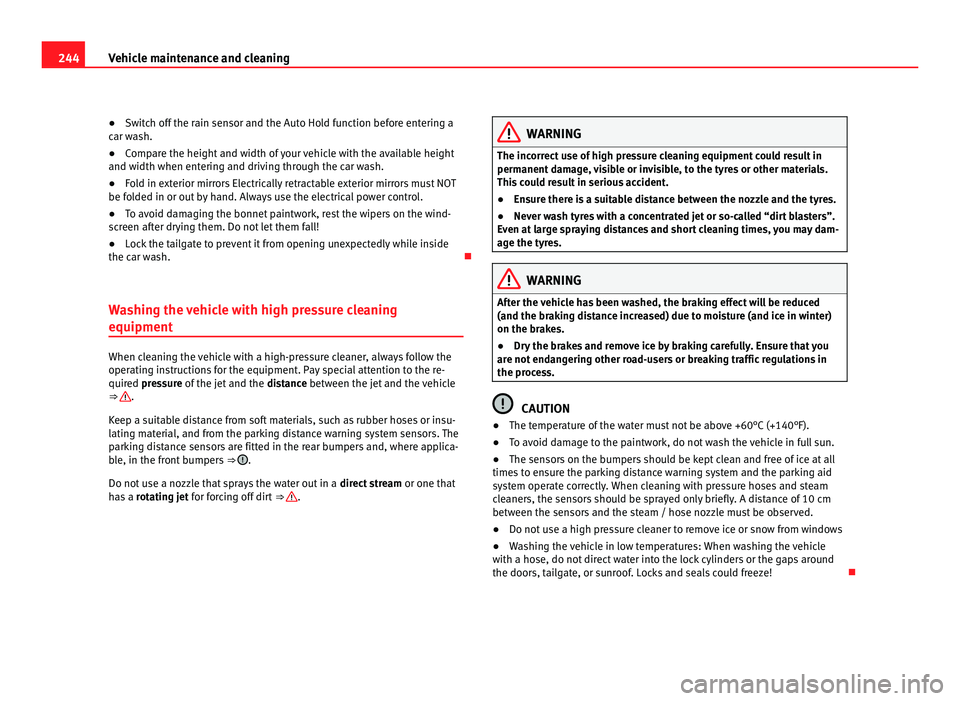
244
Vehicle maintenance and cleaning
● Switch off the rain sensor and the Auto Hold function before entering a
c ar w
ash.
● Compare the height and width of your vehicle with the available height
and width when enterin
g and driving through the car wash.
● Fold in exterior mirrors Electrically retractable exterior mirrors must NOT
be fol
ded in or out by hand. Always use the electrical power control.
● To avoid damaging the bonnet paintwork, rest the wipers on the wind-
scr
een after drying them. Do not let them fall!
● Lock the tailgate to prevent it from opening unexpectedly while inside
the car wa
sh.
Washing the vehicle with high pressure cleaning
equipment When cleaning the vehicle with a high-pressure cleaner, always follow the
operatin
g in
structions for the equipment. Pay special attention to the re-
quired pressure of the jet and the distance between the jet and the vehicle
⇒ .
Keep a s uit
able distance from soft materials, such as rubber hoses or insu-
lating material, and from the parking distance warning system sensors. The
parking distance sensors are fitted in the rear bumpers and, where applica-
ble, in the front bumpers ⇒ .
Do not u se a no
zzle that sprays the water out in a direct stream or one that
has a rotating jet for forcing off dirt ⇒ . WARNING
The incorrect use of high pressure cleaning equipment could result in
permanent d
amage, visible or invisible, to the tyres or other materials.
This could result in serious accident.
● Ensure there is a suitable distance between the nozzle and the tyres.
● Never wash tyres with a concentrated jet or so-called “dirt blasters”.
Even at
large spraying distances and short cleaning times, you may dam-
age the tyres. WARNING
After the vehicle has been washed, the braking effect will be reduced
(and the brakin
g distance increased) due to moisture (and ice in winter)
on the brakes.
● Dry the brakes and remove ice by braking carefully. Ensure that you
are not end
angering other road-users or breaking traffic regulations in
the process. CAUTION
● The temperature of the water must not be above +60°C (+140°F).
● To av
oid damage to the paintwork, do not wash the vehicle in full sun.
● The sensors on the bumpers should be kept clean and free of ice at all
times t
o ensure the parking distance warning system and the parking aid
system operate correctly. When cleaning with pressure hoses and steam
cleaners, the sensors should be sprayed only briefly. A distance of 10 cm
between the sensors and the steam / hose nozzle must be observed.
● Do not use a high pressure cleaner to remove ice or snow from windows
● Washing the vehicle in low temperatures: When washing the vehicle
with a hose, do not
direct water into the lock cylinders or the gaps around
the doors, tailgate, or sunroof. Locks and seals could freeze!
Page 247 of 385
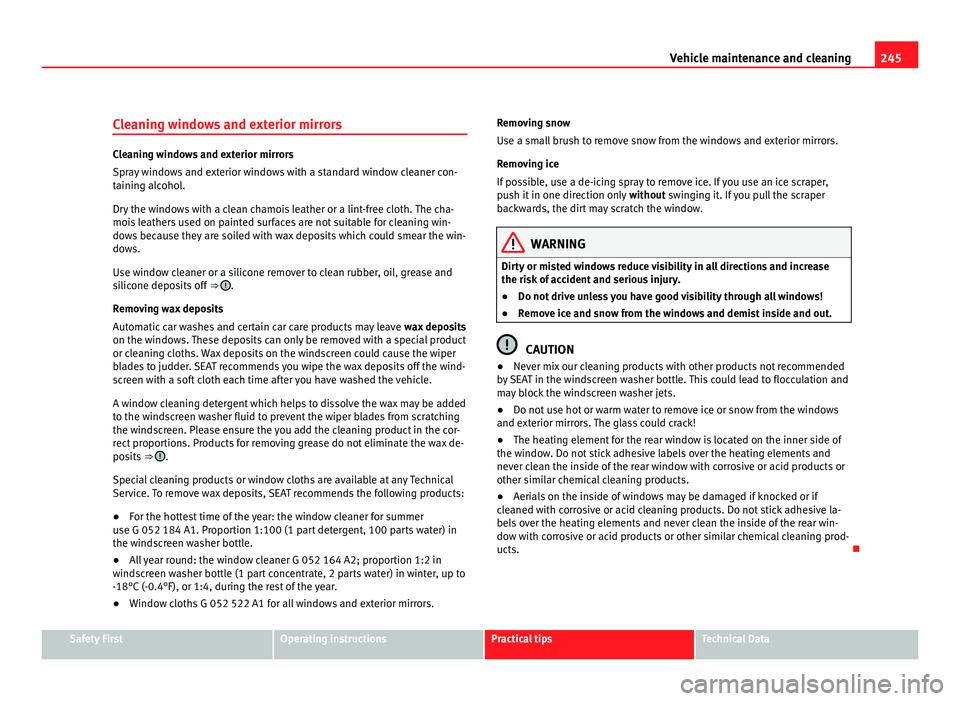
245
Vehicle maintenance and cleaning
Cleaning windows and exterior mirrors Cleaning windows and exterior mirrors
Spr
a
y windows and exterior windows with a standard window cleaner con-
taining alcohol.
Dry the windows with a clean chamois leather or a lint-free cloth. The cha-
mois leathers used on painted surfaces are not suitable for cleaning win-
dows because they are soiled with wax deposits which could smear the win-
dows.
Use window cleaner or a silicone remover to clean rubber, oil, grease and
silicone deposits off ⇒ .
Remo v
ing wax deposits
Automatic car washes and certain car care products may leave wax deposits
on the windows. These deposits can only be removed with a special product
or cleaning cloths. Wax deposits on the windscreen could cause the wiper
blades to judder. SEAT recommends you wipe the wax deposits off the wind-
screen with a soft cloth each time after you have washed the vehicle.
A window cleaning detergent which helps to dissolve the wax may be added
to the windscreen washer fluid to prevent the wiper blades from scratching
the windscreen. Please ensure the you add the cleaning product in the cor-
rect proportions. Products for removing grease do not eliminate the wax de-
posits ⇒ .
Spec i
al cleaning products or window cloths are available at any Technical
Service. To remove wax deposits, SEAT recommends the following products:
● For the hottest time of the year: the window cleaner for summer
use G 052 184 A1. Propor
tion 1:100 (1 part detergent, 100 parts water) in
the windscreen washer bottle.
● All year round: the window cleaner G 052 164 A2; proportion 1:2 in
winds
creen washer bottle (1 part concentrate, 2 parts water) in winter, up to
-18°C (-0.4°F), or 1:4, during the rest of the year.
● Window cloths G 052 522 A1 for all windows and exterior mirrors. Removing snow
Use a smal
l brush to remove snow from the windows and exterior mirrors.
Removing ice
If possible, use a de-icing spray to remove ice. If you use an ice scraper,
push it in one direction only without swinging it. If you pull the scraper
backwards, the dirt may scratch the window. WARNING
Dirty or misted windows reduce visibility in all directions and increase
the risk of
accident and serious injury.
● Do not drive unless you have good visibility through all windows!
● Remove ice and snow from the windows and demist inside and out. CAUTION
● Never mix our cleaning products with other products not recommended
b y
SEAT in the windscreen washer bottle. This could lead to flocculation and
may block the windscreen washer jets.
● Do not use hot or warm water to remove ice or snow from the windows
and exterior mirr
ors. The glass could crack!
● The heating element for the rear window is located on the inner side of
the window
. Do not stick adhesive labels over the heating elements and
never clean the inside of the rear window with corrosive or acid products or
other similar chemical cleaning products.
● Aerials on the inside of windows may be damaged if knocked or if
cle
aned with corrosive or acid cleaning products. Do not stick adhesive la-
bels over the heating elements and never clean the inside of the rear win-
dow with corrosive or acid products or other similar chemical cleaning prod-
ucts. Safety First Operating instructions Practical tips Technical Data
Page 248 of 385

246
Vehicle maintenance and cleaning
Cleaning and changing windscreen wiper blades Fig. 158 Changing the
front
w
iper blades Fig. 159 Changing the
re
ar w
iper blade.
The windscreen wiper blades are supplied as standard with a layer of graph-
ite. Thi
s layer is responsible for ensuring that the wipe is silent. If the graph-
ite layer is damaged, the noise of the water as it is wiped across the wind-
screen will be louder. Check the condition of the wiper blades regularly.
If the wiper
s scrape
across the glass they should be changed if they are damaged, or cleaned if
they are dirty ⇒ .
Damag ed w
iper blades should be replaced immediately. Blades are availa-
ble from qualified workshops.
Lifting and unfolding the wiper arms
The wiper arm may only be lifted at the point where it is fastened to the
blade.
For windscreen wipers, please note: the wiper should be in service position
before unfolding it ⇒ page 105.
Cleaning windscreen wiper blades
● Lifting and unfolding the wiper arms.
● Use a soft cloth to remove dust and dirt from the windscreen wiper
bla
des.
● If the blades are very dirty, a sponge or damp cloth may be used ⇒ .
Chan gin
g the front wiper blades
● Lifting and unfolding the wiper arms.
● Hold down the release button ⇒ fig. 158 1 while gently pulling the
bl a
de in the direction of the arrow.
● Fit a new wiper blade of the same len
gth and design on to the wiper arm
and hook it into place.
● Rest the wiper arms back onto the windscreen.
Changin
g the rear wiper blade
● Lift and unfold the wiper arm.
● Pull the wiper blade out of its mounting on the wiper arm ⇒ fig. 159 (ar-
ro
w A ).
● Hold down the release button 1 while gently pulling the blade in the
direction of the arr
ow B . This may require some strength.
Page 249 of 385
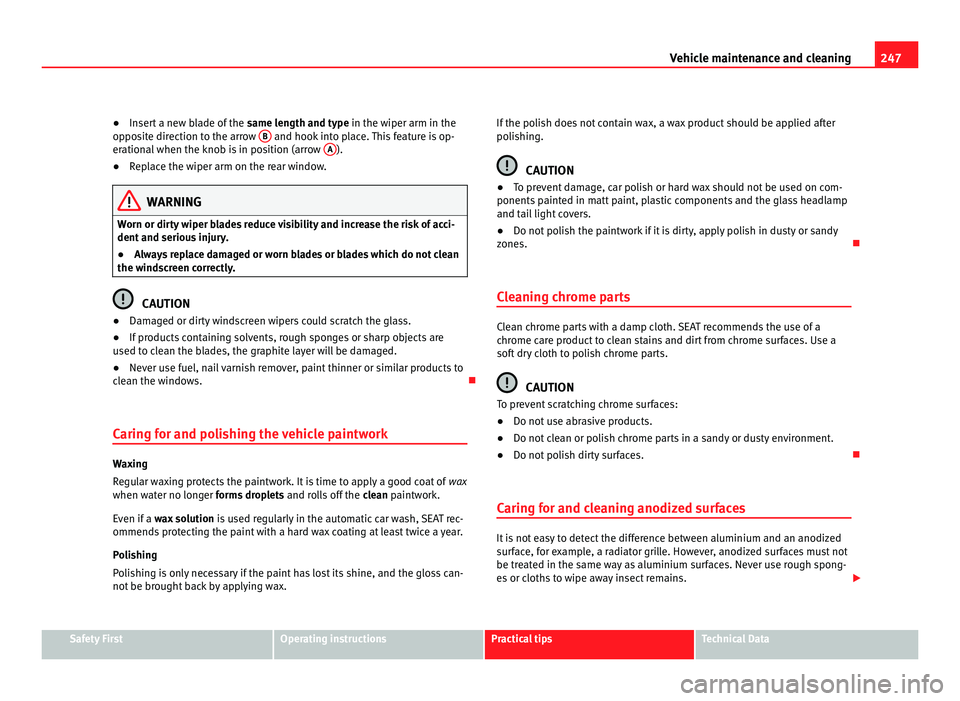
247
Vehicle maintenance and cleaning
● Insert a new blade of the same l ength and type in the wiper arm in the
opposite direction to the arrow B and hook into place. This feature is op-
eration al
when the knob is in position (arrow A ).
● Replace the wiper arm on the rear window. WARNING
Worn or dirty wiper blades reduce visibility and increase the risk of acci-
dent and seriou s
injury.
● Always replace damaged or worn blades or blades which do not clean
the winds
creen correctly. CAUTION
● Damaged or dirty windscreen wipers could scratch the glass.
● If pr
oducts containing solvents, rough sponges or sharp objects are
used to c
lean the blades, the graphite layer will be damaged.
● Never use fuel, nail varnish remover, paint thinner or similar products to
cle
an the windows.
Caring for and polishing the vehicle paintwork Waxing
Re
gu
lar waxing protects the paintwork. It is time to apply a good coat of wax
when water no longer forms droplets and rolls off the clean paintwork.
Even if a wax solution is used regularly in the automatic car wash, SEAT rec-
ommends protecting the paint with a hard wax coating at least twice a year.
Polishing
Polishing is only necessary if the paint has lost its shine, and the gloss can-
not be brought back by applying wax. If the polish does not contain wax, a wax product should be applied after
polishin
g. CAUTION
● To prevent damage, car polish or hard wax should not be used on com-
ponents p
ainted in matt paint, plastic components and the glass headlamp
and tail light covers.
● Do not polish the paintwork if it is dirty, apply polish in dusty or sandy
zones.
C
leaning chrome parts Clean chrome parts with a damp cloth. SEAT recommends the use of a
chr
ome c
are product to clean stains and dirt from chrome surfaces. Use a
soft dry cloth to polish chrome parts. CAUTION
To prevent scratching chrome surfaces:
● Do not use abrasive products.
● Do not clean or polish chrome parts in a sandy or dusty environment.
● Do not polish dirty surfaces.
Caring for and cleaning anodized surfaces It is not easy to detect the difference between aluminium and an anodized
sur
f
ace, for example, a radiator grille. However, anodized surfaces must not
be treated in the same way as aluminium surfaces. Never use rough spong-
es or cloths to wipe away insect remains. Safety First Operating instructions Practical tips Technical Data
Page 250 of 385
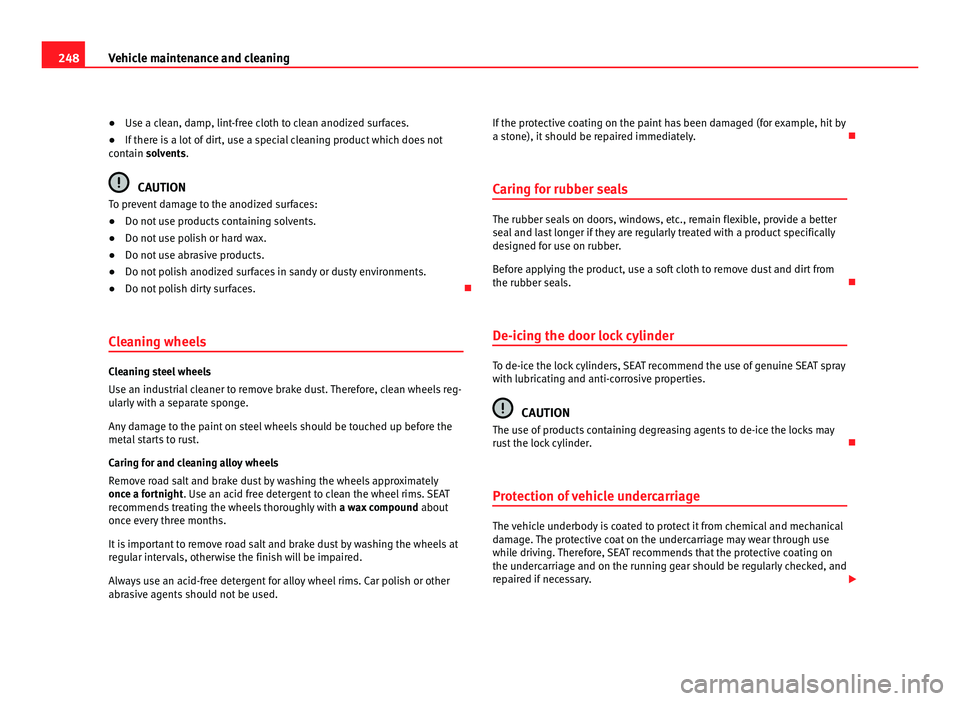
248
Vehicle maintenance and cleaning
● Use a clean, damp, lint-free cloth to clean anodized surfaces.
● If ther
e is a lot of dirt, use a special cleaning product which does not
contain
solvents. CAUTION
To prevent damage to the anodized surfaces:
● Do not use products containing solvents.
● Do not use polish or hard wax.
● Do not use abrasive products.
● Do not polish anodized surfaces in sandy or dusty environments.
● Do not polish dirty surfaces.
Cleaning wheels Cleaning steel wheels
Use an indu
s
trial cleaner to remove brake dust. Therefore, clean wheels reg-
ularly with a separate sponge.
Any damage to the paint on steel wheels should be touched up before the
metal starts to rust.
Caring for and cleaning alloy wheels
Remove road salt and brake dust by washing the wheels approximately
once a fortnight. Use an acid free detergent to clean the wheel rims. SEAT
recommends treating the wheels thoroughly with a wax compound about
once every three months.
It is important to remove road salt and brake dust by washing the wheels at
regular intervals, otherwise the finish will be impaired.
Always use an acid-free detergent for alloy wheel rims. Car polish or other
abrasive agents should not be used. If the protective coating on the paint has been damaged (for example, hit by
a stone), it
should be repaired immediately.
Caring for rubber seals The rubber seals on doors, windows, etc., remain flexible, provide a better
seal
and l
ast longer if they are regularly treated with a product specifically
designed for use on rubber.
Before applying the product, use a soft cloth to remove dust and dirt from
the rubber seals.
De-icing the door lock cylinder To de-ice the lock cylinders, SEAT recommend the use of genuine SEAT spray
with lubric
atin
g and anti-corrosive properties. CAUTION
The use of products containing degreasing agents to de-ice the locks may
rus t
the lock cylinder.
Protection of vehicle undercarriage The vehicle underbody is coated to protect it from chemical and mechanical
dam
ag
e. The protective coat on the undercarriage may wear through use
while driving. Therefore, SEAT recommends that the protective coating on
the undercarriage and on the running gear should be regularly checked, and
repaired if necessary.